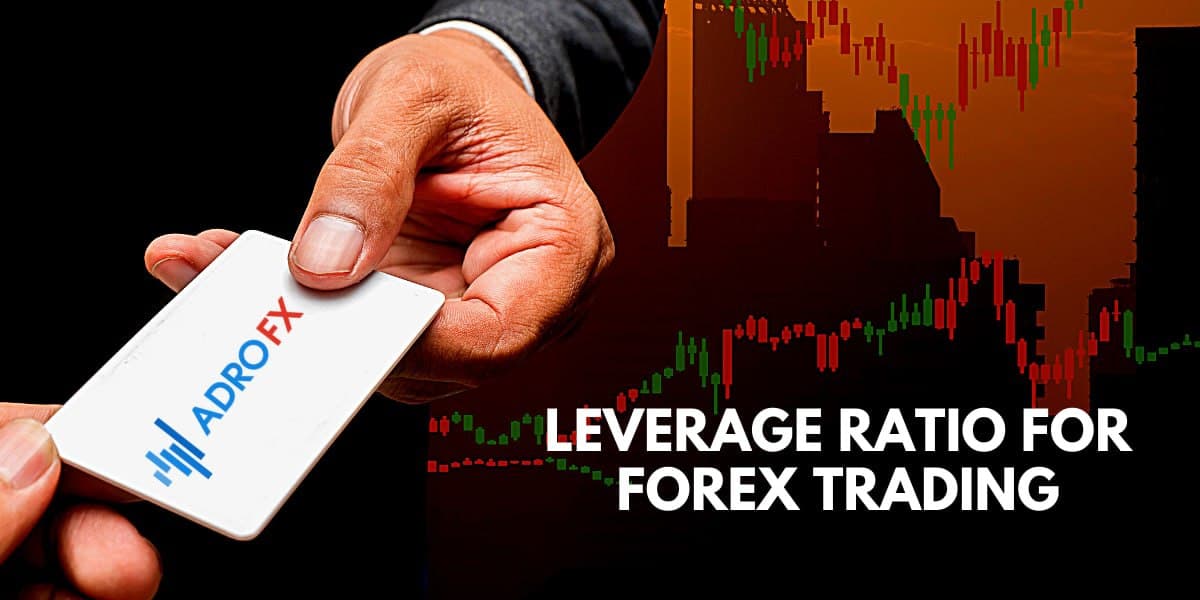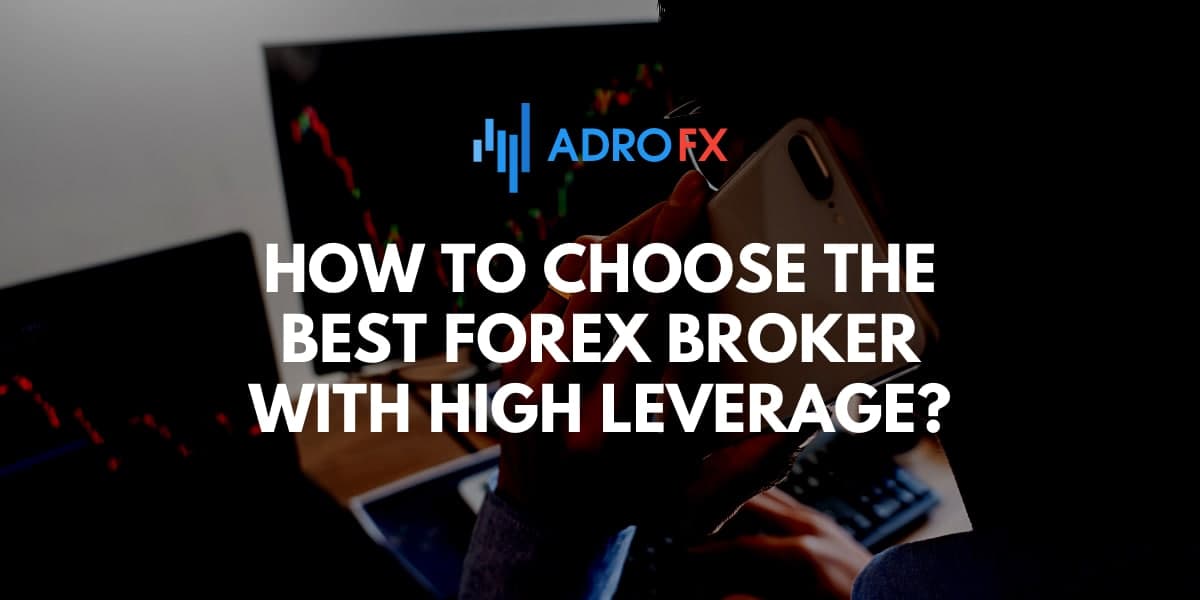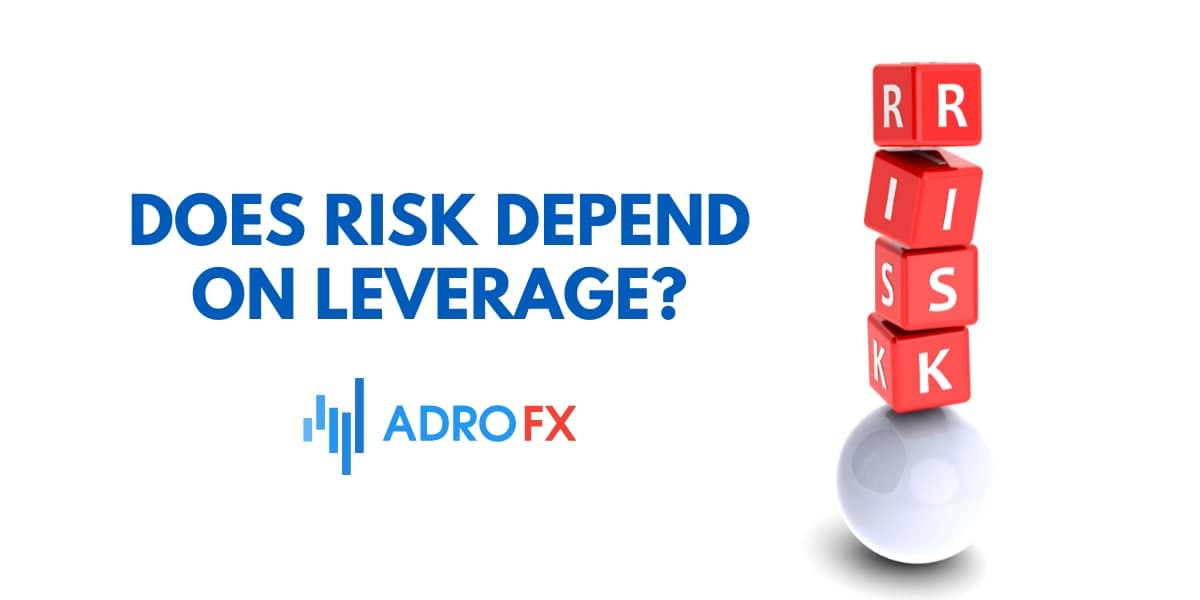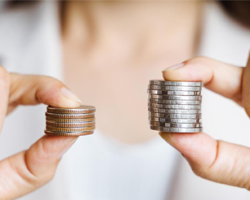Best Leverage Ratio for Forex Trading

One of the reasons why Forex is more popular among traders than other financial instruments is the possibility of using high leverage. Despite the widespread use of the term "leverage," few people understand its true meaning and effect on trading.
That is why today we will talk about leverage and will answer the most common questions: what that is, how to calculate it, and what is the best leverage for forex trading.
What is Leverage Ratio?
Leverage is the use of borrowed capital to build up investments with small amounts invested to take a more serious position in the market for assets of any kind. Investors use leverage in an attempt to increase their returns. If successful, the resulting return minus your ownership can far exceed your initial capital. If unsuccessful, your losses will be just as great.
Leverage is integrated into certain financial products, including options and other derivatives. Contracts for Difference (CFDs) are well suited for leveraged trading. Another definition of leverage refers to the ratio of a company's debt to its equity.
Let's look at an example. Simon has a $5000 account with a broker and decides to trade 1 whole lot of USD/JPY. By trading 1 lot, Simon is trading $100,000. If he uses 1:100 leverage, a $1,000 deposit is taken from his account and $99,000 is provided by the broker. Only 1 hundredth of the required amount goes from Simon's account. That's the power of a 1:100 leverage.
So how does the brokerage protect itself from a potential loss of deposit? Very simple: Simon`s potential loss is limited to the amount in his account. Let's assume that the position opened by Simon is losing and the price continues to move against him.
After reaching a level of uncovered losses, say $4,000 (Simon has a total of $5,000 in his account), the broker can call Simon and ask him to deposit more funds in his account or close a part of the losing position. It is called a "Margin Call". In our computer age, of course, nobody calls clients anymore, and a position with a margin level lower than the one set by the broker is closed automatically without any notification of the client.
In Simon's case, a deposit of $1,000 is taken from his account to open a position. Let's assume that the market goes against Simon's position (which was originally worth $100,000) and the uncovered (floating) loss reaches $4,000.
So, the equity in Simon's account now equals $5,000-$4,000=$1000. When equity on the account is equal to or less than the margin required to maintain the position, a Margin Call occurs. Different brokers and account types have different margin call levels, but as a rule, it is 20-50% of the required margin. I.e., when funds on the account are reduced to, say, 30% (the level may be different for different account types) of the required margin, there is an automatic closing of trader's positions.
Let's assume that a Margin Call has been triggered on Simon's account. In this case, when the position is closed (say, with a loss of $4500), its value will be $1,000 (initial margin from Simon's account)+$99,000 (which the broker added as a credit)-$4,500(loss)=$95,500.
The broker will take all of this funds, plus he will take the missing $3500 to return the $99,000 that he lent to the trader. Thus, the entire loss on the position goes entirely to Simon's account, which only has $500 left after the trigger of the Margin Call.
Similarly, if the position brings a return, all of the gain goes to Simon, after he closes the position.
For example, Simon borrows $99,000 from his broker, and a $1,000 deposit is taken from his account; this position brings a yield of $8,000. And when the position is closed, Ivan has $99,000+1,000+$8,000=$108,000.
After the position is closed, $99,000 will be returned to the broker, $1,000 of the deposit will go back to Simon`s account, and $8,000 of the return will also go to his account.
This is leverage - a double-edged sword that can turn a small deposit into a fortune or wipe out your account in the blink of an eye.
What Leverage Ratio is Good for a Beginner
Just take your first steps in trading and wonder what is the best forex leverage for beginners? You have to decide on the size of your leverage at the account opening stage. Keep in mind that it is wrong to think that leverage can influence trading results. More importantly, the higher the leverage, the lower the margin (the amount of margin required to open a trade).
Different brokers offer different types of leverage - from the smallest 1:10 to a very aggressive 1:1000. High leverage allows opening positions with big lots with small amounts on account, but this, in its turn, is associated with big risks. But the mechanism of providing a loan on credit leverage is designed in such a way, that a trader cannot lose more than he has on his account. To reduce the risks when trading on the currency exchange with high leverage, it is necessary to strictly follow the rules of capital management.
To carry out margin trading, it is necessary to adhere to the following rules:
Having chosen a strategy, you should first test it on a demo account. It will help calculate the risks and avoid a lot of mistakes.
Trader's calculator is designed to calculate the possible losses (not more than 2-5% of the deposit). It is worth using this option as often as possible.
Given the ratio of leverage selected, determine the volume of trade, which will be the most effective and the least risky.
There is a particular feature: if there are little funds in the account, with little experience in using it and low leverage, it will quickly go unsuccessful, because the trader will not be able to react quickly to the changes in the market.
But on the other hand, with high leverage, the risk of losing all the deposit increases several times. Besides, it is more difficult for a beginner to control the situation, and he can suffer from the random processes not uncommon in Forex.
Take note: leverage of 1:20 makes aggressive trading less risky, while 1:500 gives you a chance to place a big order that may result in two possible outcomes: huge returns and huge losses.
Optimal for beginners with a deposit of $300 - $1000 is considered the size of the chosen financial leverage 1:50 - 1:100. It allows opening several positions and minimizing the risk of losing a deposit at once. But there are situations when it is necessary to change leverage which is better to do when you already have experience of work on Forex.
This service is not provided by all brokers. To make it happen, you need to go to your Live Account on the company's official website and send an application to change your leverage ratio. The review may take 1 to 3 business days. But to choose, you just need to specify the desired leverage size when opening an account.
The choice of leverage is vital not only for beginners with a small deposit. Using this tool, experienced traders have more room to maneuver in critical situations. But no matter what leverage you have, there is always the risk of losing your deposit, because Stop-Loss levels can be triggered for a variety of reasons.
How to Choose the Best Forex Broker with High Leverage?

While finding a high leverage trading platform is important, factors such as asset selection, commissions, and ease of use should also not be overlooked.
If a broker provides high leverage, it does not mean anything. Don't open an account with the company right away; you need to find answers to the key questions first:
- What assets does the broker provide for trading?
- What are the commissions and other fees?
- Does the broker have accreditation from a leading financial authority?
- What payment methods does the broker provide?
- Is the broker suitable for beginners?
In general, there are many different factors to consider when comparing brokers.
After we have carried out our own comparison of brokers, we have found out that the most advantageous broker is AdroFx: there is no commission here, and the leverage for private clients can be chosen by trader from 100 to 500. Registration on the company's website is almost instantaneous, and you can fund your account via cryptocurrencies and e-wallet.
AdroFx is best suited for experienced traders looking for an advanced platform that gives them access to huge investment opportunities and attractive leverage. The broker offers you more than 50 forex trading pairs (including all major currencies), indices, stocks, cryptocurrencies, and precious metals. The leverage is chosen by the client when opening an account.
Beginner traders who wish to gain a deeper understanding of the Forex market can do so on an AdroFx demo account. It's free and has no limit on the amount of time or virtual currency you can spend there. Other factors that set it apart from the competition, despite being only three years old, include its zero deposit and withdrawal fees approach. Plus the fact that you only need $25 to open a real trading account.
Overall best leverage for Forex with Examples
Choosing the most appropriate leverage for your forex trading account is important and will require a great deal of your attention. As you move from demo trading to live trading, you may find that you have not given much thought to your leverage up to this point. By practicing trading on a demo account, most traders focus their efforts solely on trading, improving their skills and understanding, and creating a trading strategy in which leverage plays an important role.
Many non-European Forex brokers offer leverage up to 1:500, which is, basically, okay. Some brokers give higher leverage, which sometimes reaches 1:3000, but such high leverage is not common and not recommended.
Brokers whose leverage reaches 1:500 usually allow traders to adjust its size by themselves, which raises the question: "What leverage should I use for forex trading?"
When choosing leverage you need to consider the following:
- The amount you are going to deposit into your account.
- Your risk to return ratio, i.e. the percentage of allowable drawdown in your account.
- The number of positions you can afford to open at one time.
Leverage is undoubtedly one of the main advantages of the forex market. Thanks to it, traders with a modest margin can get much-needed access to many financial markets. The problem with many novice traders is that they have a habit of choosing the maximum leverage possible. "maximum" leverage for novice Forex traders is not always the best.
High leverage can only be useful if used correctly. Beginning traders often take advantage of the opportunity provided by leverage to open larger positions to achieve higher and faster trading results. However, such high leverage has its own drawback: every time a position fails to produce the expected results, larger losses will result in even larger margin cuts, which are required to open the next trade.
We have prepared for you a couple of scenarios that are meant to help you choose the best forex leverage.
1. The best forex leverage for accounts from $10 and up to $500
With a trading account balance of only $10, you will need leverage high enough to be able to open a trade, and you should have enough free margin left in your account to allow it to survive a small drawdown.
For example, with 1:500 leverage you could open a $2000 position in GBP/USD with only $5.00 of margin. Sure, that sounds great, but in this example, your account balance is $10, half (50%) of which is used margin and the rest is free ($5) margin needed to open other trades (you better not do that).
Most brokers have a Stop Out level set at 50%. If the point value is $0.20, it means that if your position incurs a loss of 45 pips, your margin level will be nearly 100%, and your position will come dangerously close to the stop-out level.
If your account balance is $500, the events described above will unfold in a completely different scenario. In this case, your account will have enough free margin to cope with any temporary drawdown. As a rule of thumb, inexperienced traders will still use this extra room to maneuver to open more positions or increase the size of their positions.
2. The best forex leverage for accounts from $500 and up to $2000
A more realistic option is to fund your trading account with $500 or more, even if you are a beginner. A small account needs high leverage, and you run the risk of losing a significant portion of the funds in your account.
The best leverage for a $2,000 account will also depend on how many positions you intend to keep open at one time. With 1:100 leverage, you can only use about 1% of the available margin to open a 0.02 lot position. Compare this example to the previous one, where it took 50% of the available margin to maintain a position of similar size.
Here it always depends on the trading style of the trader. Long-term investors, for example, do not need high leverage. Short-term traders, on the other hand, who trade only small movements with high positions, need high leverage. There, the size of the position should be higher.
Thus, leverage should be tailored to your trading style. Ultimately, however, the trader still determines his own risk on the size of the position. Leverage can't change that much. Leverage does not change the risk or danger in a trade. It is up to the trader himself.
Does risk depend on leverage?
There is an opinion that risks in forex trading directly depend on the level of leverage. Let us look into this matter, and to make it clear, let us use examples again. Suppose the trader buys 1 lot, but he will do it in two accounts with different leverage values. The first will be 1:100, and the second 1:1000, but in both cases, we will have $3000 on the deposit.
At 1:100, to buy 1 lot will require a deposit of $1000, and a change in the market price by 1 point will add or subtract $10 from your account (if the price goes to the plus side of the trade) for each point +$10, and if it goes to the minus side, then -$10). For example, at a drawdown of 80 pips, the trader will lose $800 of his funds.
At 1:1000, to buy 1 lot only $100 will be enough, but a market price change of 1 point will still add or subtract $10 from the deposit. At the same 80 point drawdown, the speculator's loss will be the same $800.
It turns out that risks don't depend directly on the leverage; the point value is "attached" to the volume of position in lots. Changing the value of leverage only changes the amount of margin, and it becomes only an indirect cause of increasing/decreasing the risk. Why does this happen, what is the reason?
In this case, the problem can be attributed to psychological factors because with a small deposit a trader on forex still has a lot of free funds for which he can buy new volumes. The trader gets an opportunity to open more positions violating permissible risks, and the total volume of all opened deals can be very big.
To use this tool correctly, follow some simple recommendations:
- Be guided exactly by your own deposit. Calculate the risks based on the amount available.
- It is better to use a small amount of borrowed funds, which will not allow you to lose all your capital at once.
- Never trade with the whole deposit, regardless of the leverage size. Ideally, one trade should take 1-2% of the deposit.
- Be sure to place Stop-Loss levels, it will help reduce risks.
Thus, leverage - is a good financial tool for those who have already learned how to manage capital and have a low percentage of losing trades. In the hands of an inexperienced trader, such a tool may lead to the complete loss of his own funds.
Leverage FAQ
What is leverage?
Leverage is a ratio between the personal funds of a trader and borrowed funds provided by a broker on special terms. Exactly the use of leverage allows trading at the Forex market even those traders who do not have big sums for placing orders. If we consider an example, let us take the cost of a standard lot, which is 100,000 U.S. dollars. Using 1:100 leverage reduces the amount of collateral required to place a 1 lot trade by a factor of 100.
Is leverage good or bad?
In the hands of a professional - good, in the hands of someone who does not know how to use it - bad. Fast increase of position volume with borrowed funds to gain maximal income against the rules of risk-management leads to losses. A professional trader chooses leverage, based on the acceptable volume of a position according to the risk management rules and the risk level of a strategy.
What is the minimum leverage ratio?
The minimum ratio is 1:1. It means that a trader can open an order with the maximum volume corresponding to his deposit. The broker's credit in this case is not involved (we can say that there is no leverage).
Why is leverage dangerous?
In itself, leverage, if used wisely, allows you to achieve higher returns. But this is in skillful hands, and what to say about the beginners? Beginners trade haphazardly, and therefore they can be lucky for a long time, but one day they start to lose funds. The leverage only hastens the process of bankruptcy, and that is its danger. The main danger of the leverage is that a broker can forcibly close a position if the client's assets decrease below a certain margin level (some brokers have it at 25% for standard clients, i.e. the ratio of assets to credit will be 1 to 3). That generates psychological pressure on the trader, forcing him to take irrational actions such as selling the stock at the bottom of the market and buying at the top.
How to calculate leverage?
- It is important to determine the desired amount for the trade in the Forex market.
For example, let it be equal to $50,000.
- The trader should use a standard leverage ratio of 1:100, which, from the point of view of margin, will mean that a deposit equal to 1% of personal funds must be made.
- It is necessary to calculate the amount of required margin from the deposit, which will be reserved on your account by the broker.
So, 1% of the amount of $50,000 will be equal to $500.
As a result, when crediting the trader, there will be an effect of leverage equal to a hundred.
The formula for determining the collateral position will be as follows:
The amount of collateral = the volume of the open position / the selected level of leverage.
Remember that the Forex market standard volume of 1 lot is usually considered equal to 100,000 units of the base currency, so the volume of 0.1 lot will be 10,000 units of the base currency.
Accordingly, the required level of margin will be different. For those who do not wish to bother with calculations by hand, usually, each financial institution has a special trader calculator, with the help of which all calculations can be performed quickly and very accurately.
What is the leverage offered by AdroFx?
AdroFx offers different levels of leverage which means trader can choose the one that suits better. It can be 100, 200, 300, 400, or 500.
Conclusion
Wrapping up, we need to say that there is no one-size-fits-all leverage that will work for everyone new to the Forex market and every situation. It all depends on the capital you are trade with and risk appetite, as well as the volume and number of trades you place every day. The best advice any trader can give you is to be extremely careful with your leverage. By referring to our examples, you can find out for yourself which leverage is considered best exactly for your trading strategy.
About AdroFx
Being a well-established brokerage company, AdroFx offers the best trading conditions to its clients from 200 countries. Founded by experts with a couple of decades of overall experience, AdroFx is one of the best platforms on the market for shares trading. Either a newbie or experienced trader, both will find here what they are looking for since the company provides various trading accounts for different trading styles and goals.











